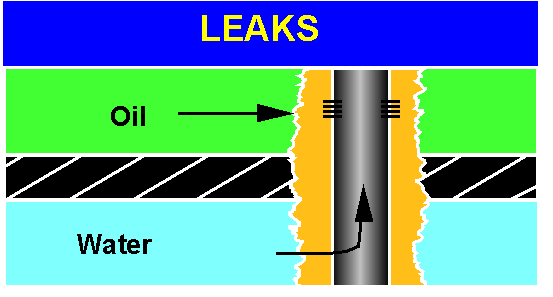Casing Leaks
Problems 1 and 4 in Table 1

A few comments may be helpful to clarify some of the listings in Table 1. First, the difference between Problems 1 and 4 is simply a matter of aperture size of the casing leak and size of the flow channel behind the casing leak. Problem 1, involving casing leaks without flow restrictions, is where the leak is occurring through a large aperture breach in the piping (greater than roughly 1/8 in.) and a large flow conduit (greater than roughly 1/16 in.) behind the leak. The use of Portland cement is favored for treating Problem 1. Problem 4, involving casing leaks with flow restrictions, is where the leak is occurring through a small aperture breach (e.g., “pinhole” and tread leaks) in the piping (less than roughly 1/8 in.) and a small flow conduit (less than roughly 1/16 in.) behind the leak. The use of gel is favored to successfully treat Problem 4. Here, the gels under discussion may include those formed from
- chemically crosslinking water-soluble organic polymers,
- water-based organic monomers, or
- silicates.
The most common methods to repair casing leaks (i.e., for Problem 1) involve either cement27,28 or mechanical patches.2,29 However, these methods have generally not been very successful when treating small casing leaks, such as “pinhole” or thread leaks (Problem 4). In particular, cement has difficulty penetrating through small leaks. With luck, cement may lodge in and plug the leak, but small mechanical shocks often easily dislodge the cement plug. Gel treatments can be more successful for these applications.30-32 Appropriately designed gelants flow easily through the small casing leaks and some distance into the formation surrounding the leak. Thus, the gel treatment is directed at stopping flow in the porous rock around the vicinity of the casing leak, rather than solely attempting to permanently plug the casing leak itself. If the resultant gel (placed in the matrix reservoir rock) can withstand the near wellbore pressure gradients, a small radius of penetration (e.g., ~1 ft) may be adequate to stop flow. Consequently, gelant volumes can be quite small. Of course, greater gel volumes and/or other treatment methods may be needed if flow behind pipe or fractures exist in the vicinity of the casing leak.
What placement and permeability reduction properties are desired for gels used to plug casing leaks? Since the objective is to achieve total water shutoff from the leak and since small gel volumes are often used for this application, the gel plug should be relatively strong and must have a very low permeability. Rigid gels can be prepared from several materials that yield permeabilities in the low microdarcy range.33,34 Gels for this application have often been formulated with relatively high concentrations (4-7%) of acrylamide polymers having a relatively low molecular weight (on the order of 250,00 to 500,000 daltons).35 Gelants for this application should be of relatively low viscosity and experience essentially no crosslinking of the polymer during gel treatment placement.
Refs. 30-33 provide field examples where gels showed superior behavior over cement when treating leaks.